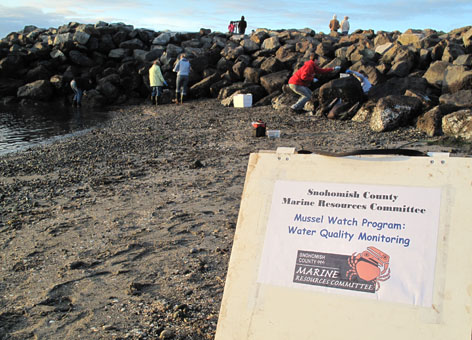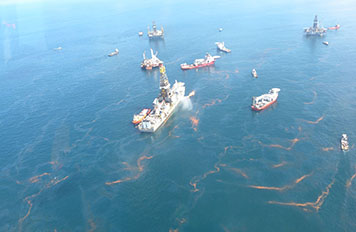NOAA Partners with University of Washington to Examine How Citizen Science Can Help Support Oil Spill Response
This is a guest post by University of Washington graduate students Sam Haapaniemi, Myong Hwan Kim, and Roberto Treviño.
FEBRUARY 2, 2015 -- Citizen science—characterized by public participation in the scientific process—is a growing trend in scientific research. As technology opens up new opportunities, more and more people are able to collaborate on scientific efforts where widespread geographic location or project scope previously may have been a barrier.
Citizen science can take a number of forms, ranging from small-scale environmental monitoring to massive crowdsourced classification efforts, and there is a great deal of benefit to be realized when managed properly. For example, the NOAA National Severe Storms Laboratory developed the mPING smartphone app to allow anyone in the United States to file hyper-local weather reports, which in turn helps the NOAA National Weather Service fine-tune their weather forecasts.

The Citizen Science Management Project
Our team of University of Washington graduate students is working with NOAA's Office of Response and Restoration to research the potential for incorporating citizen science into its oil spill response efforts.
Thanks to improvements in technology, the public is more interested in and better able to contribute help during oil spills than ever before. During recent oil spills, notably the 2010 Deepwater Horizon incident, large numbers of citizens have expressed interest in supporting monitoring and recovery efforts. As the lead science agency for oil spills, NOAA is considering how to best engage the public in order to respond to oil spills even more effectively.
The goal of the project is to provide recommendations for NOAA on effective citizen science management. To do this, we began working to find the most current and relevant information on citizen science by conducting a broad review of the published scientific literature and speaking with experts in the fields of oil spill response, citizen science, and coastal volunteer management. Our next steps are to analyze the research and come up with possible options for NOAA's Office of Response and Restoration on how to best adopt and incorporate citizen science into its work.

Initial Findings
NOAA's Role. NOAA's role in an oil spill response is primarily that of scientific support. During a response, NOAA begins by addressing a few core questions. Phrased simply, they are:
- What got spilled?
- Where will it go and what will it hit?
- What harm will it cause and how can the effects of the spill be reduced?
We believe that using citizen scientists to help answer these fundamental questions may help NOAA better engage communities in the overall response effort and produce additional usable data to strengthen the response.
Changing Trends and New Opportunities. Technology is changing quickly. More than half of Americans own a smartphone, mapping programs are readily available and easy-to-use, and the Internet provides an unparalleled platform for crowdsourced data collection and analysis, as well as a venue for communication and outreach. These advances in technology are adding a new dimension to citizen science by creating the ability to convey information more quickly and by increasing visibility for citizen science projects. Increased exposure to citizen science efforts spurs interest in participation and the additional data collection capacity provided by smartphones and other technology allows more people to contribute.
One such trend is the digital mapping of crowdsourced information, such as the NOAA Marine Debris Program's Marine Debris Tracker app, which enables people to map and track different types of litter and marine debris they find around the world.
Oil Spills, NOAA, and Citizen Science. In 2012 the National Response Team prepared a document on the “Use of Volunteers: Guidelines for Oil Spills,” outlining ways in which oil spill responders can move toward improved citizen involvement before, during, and after an oil spill. We will use this as a framework to assess potential citizen science programs that could be adopted or incorporated by NOAA’s Office of Response and Restoration.
Challenges. All citizen science programs face certain challenges, such as ensuring data reliability with increased participation from non-experts, finding and maintaining the capacity required to manage a citizen science program and incorporate new data, and working with liability concerns around public participation. The challenges become even greater when incorporating citizen science into oil spill response. The unique challenges we have identified are the compressed timeline associated with a spill situation; the unpredictability in scope, geography, and nature of a spill; and the heightened risk and liability that come from having volunteers involved with hazardous material spill scenarios. We will keep all of these concerns in mind as we develop our recommendations.
Next Steps
From here, our team will be analyzing our findings and developing some recommendations for NOAA's Office of Response and Restoration. We hope to identify, categorize, and assess different citizen science models that may work in a response situation, weighing the strengths and weaknesses of each model. These findings will be presented in a final report to NOAA in March 2015.
If you would like to learn more about the Citizen Science Management Project or check on our progress, please visit the project website: https://citizensciencemanagement.wordpress.com. If you have ideas about the project, feel free to reach out to us through the contact page. We would love to hear from you!
Sam Haapaniemi, Myong Hwan Kim, and Roberto Treviño are graduate students at the University of Washington in Seattle, Washington. The Citizen Science Management Project is being facilitated through the University of Washington’s Program on the Environment. It is the most recent project in an ongoing relationship between NOAA's Office of Response and Restoration and the University of Washington’s Program on the Environment.
